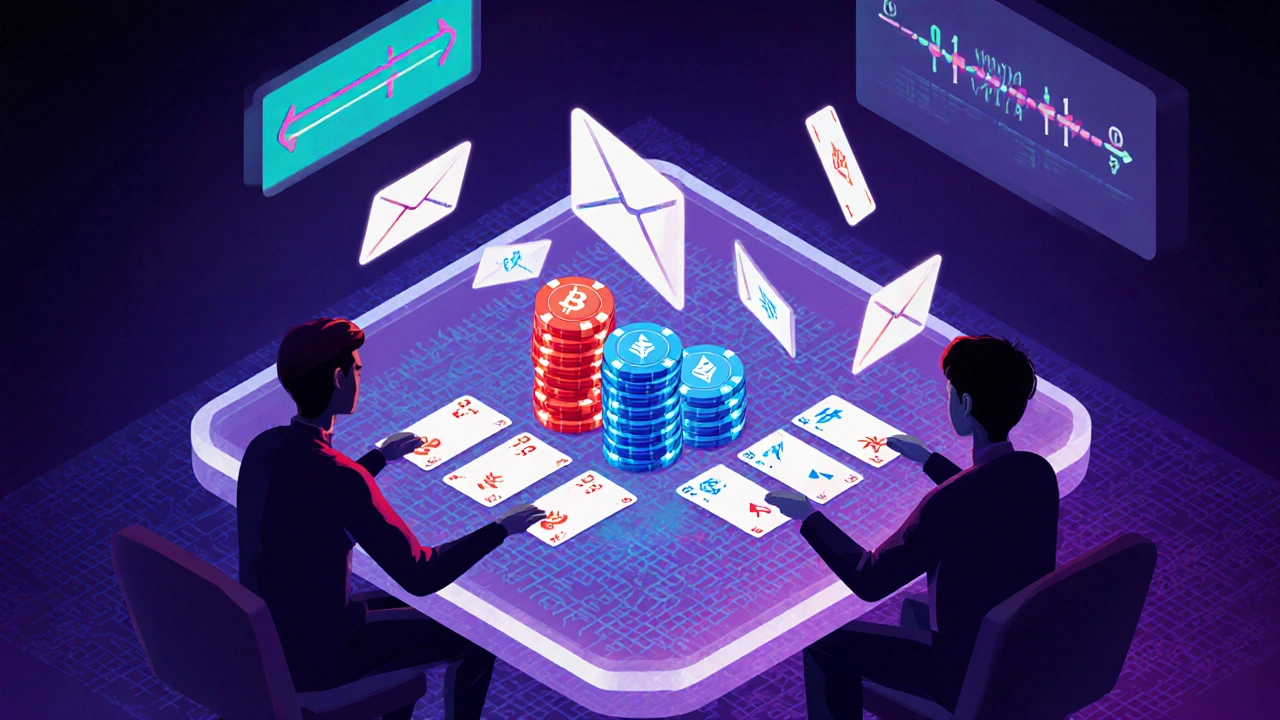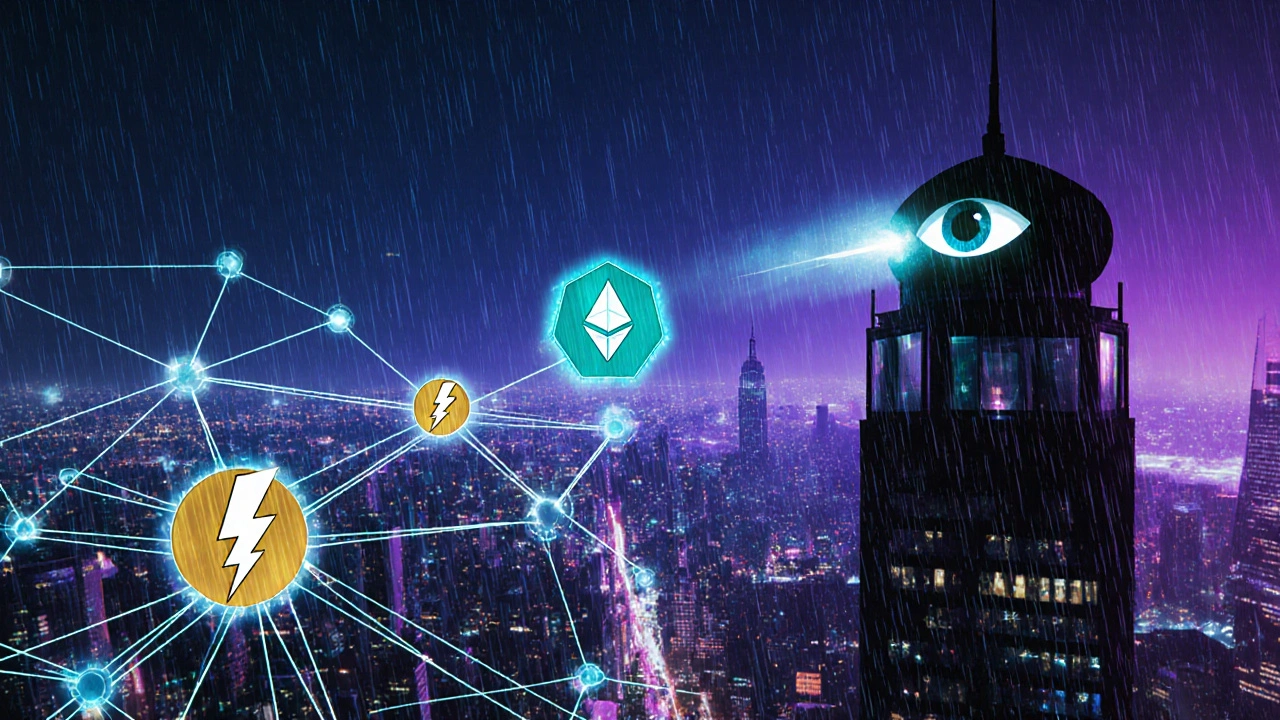Key Takeaways
- State channels move most transactions off the main chain, cutting fees and latency.
- They rely on a smart‑contract escrow and a predefined set of participants.
- Closing a channel posts a single, final settlement transaction to the blockchain.
- Lightning Network (Bitcoin) and Raiden (Ethereum) are real‑world implementations.
- Security comes from cryptographic signatures and the ability to challenge dishonest claims.
When you hear the term state channels, it often feels like jargon tossed around by blockchain developers. In reality, a state channel is a simple idea: two or more parties lock up some crypto in a smart contract, then trade back and forth off‑chain, only touching the main chain when they open or close the channel. This approach slashes transaction fees, speeds up confirmations to near‑instant, and scales the network without compromising security.
Below we break down the whole flow, from opening a channel to the cryptographic tricks that keep everyone honest. By the end you’ll know how Lightning Network on Bitcoin and Raiden on Ethereum use the same core principles, and you’ll be ready to evaluate whether a state‑channel solution fits your use case.
What a State Channel Actually Is
At its core, a State Channel is a two‑or‑more‑party off‑chain conduit that lets participants exchange signed messages representing state updates, while a smart contract on the blockchain holds collateral and enforces final settlement. Think of it as a room where you and a friend play a game of poker: you both put chips on the table (the on‑chain escrow), then you exchange bets inside the room (off‑chain messages). When the game ends, you tally up the chips and record the final winner on the main blockchain.
Why Off‑Chain Transactions Matter
Public blockchains like Bitcoin and Ethereum achieve security through consensus, but that consensus process is deliberately slow and costly. Every transaction must be broadcast, validated by dozens of nodes, and written into a block every 10‑15 seconds (Ethereum) or 10 minutes (Bitcoin). This design limits throughput to a few dozen or a few hundred transactions per second.
Enter Off-chain transaction is any transfer of value that occurs outside the main blockchain, with only periodic checkpoints recorded on‑chain. By moving most activity off‑chain, state channels dramatically boost scalability while preserving the same trust model.
Opening a State Channel: The On‑Chain Step
- Stake collateral. Each participant sends a deposit to a specially crafted smart contract. The contract holds the funds until the channel closes.
- Publish the channel contract. The contract records the participants’ addresses, the total locked amount, and a timeout value (how long the channel can stay open without activity).
- Generate a channel identifier. The contract’s address plus a unique nonce becomes the channel’s ID, which both parties use to reference the channel off‑chain.
After this step, the blockchain has a single transaction that locks funds. From here on, all interactions happen off‑chain.

Off‑Chain State Updates: Signing the Numbers
Each time participants want to exchange value, they create a new "state" - a snapshot of balances and any other agreed‑upon data. Both sides sign this state with their private keys. The signatures act like a receipt: anyone who sees the signed state can verify that both parties agreed to it.
Because signatures are lightweight (a few hundred bytes), you can send dozens or hundreds of updates per second without congesting the network.
Channel Closure: Settling On‑Chain
When the parties are done, one of them submits the latest signed state to the smart contract. The contract verifies the signatures and releases the locked funds according to the balances encoded in that state. This final transaction is the only on‑chain footprint of the entire interaction.
If one participant tries to cheat by submitting an old state that favours them, the other can challenge within the timeout period by presenting a newer signed state. The contract will honour the most recent valid state. This challenge‑response mechanism guarantees honesty.
Real‑World Implementations
Lightning Network (Bitcoin)
The Lightning Network (LN) is the most famous state‑channel network. It uses Bitcoin’s scripting capabilities to create bidirectional payment channels. LN nodes can route payments through a mesh of channels, meaning you don’t need a direct channel with every counter‑party - you just forward through intermediaries.
Raiden Network (Ethereum)
Raiden mirrors LN’s design on Ethereum, but it leverages smart contracts written in Solidity. Because Ethereum contracts can hold arbitrary logic, Raiden can support more complex state updates beyond simple transfers, such as conditional payments and multi‑party escrow.
Other Layer‑2 Solutions
Beyond classic payment channels, projects like Optimistic Rollups and ZK‑Rollups bundle many off‑chain transactions into a single on‑chain proof. While technically different, they share the same goal: move work off‑chain while preserving on‑chain security.
Security Guarantees and Common Pitfalls
- Cryptographic signatures. Every off‑chain state must be signed by all participants. Without a valid signature, the contract will reject the settlement.
- Timeouts. The on‑chain contract enforces a timeout after a closure request. If a challenger doesn’t respond in time, the submitting party wins by default.
- Watchtowers. For users who can’t stay online 24/7, third‑party watchtowers monitor the blockchain and automatically challenge outdated states on their behalf.
- Liquidity lock‑up. Funds remain idle in the escrow for the channel’s lifetime. Over‑allocating can tie up capital that could be otherwise invested.

When to Use State Channels
State channels shine in scenarios with high‑frequency, low‑value exchanges between a fixed set of parties:
- Micropayments for streaming content (pay‑per‑second video).
- Fast game‑state updates in blockchain‑based gaming.
- Frequent DeFi trades between two vaults where latency matters.
Conversely, if you need to interact with many unknown participants, a routing network like Lightning or a roll‑up might be more appropriate.
Future Trends and Research Directions
Researchers are exploring multi‑party state channels that support dozens of participants without exponential complexity. Another hot area is integrating zero‑knowledge proofs to compress the challenge process, making it cheaper to dispute old states.
As blockchains evolve to faster consensus (e.g., Ethereum’s proof‑of‑stake and sharding), state channels will continue to complement on‑chain scaling, providing the ultimate low‑latency layer for decentralized applications.
Quick Checklist for Building a State‑Channel Solution
- Define the participants and required collateral.
- Write a smart contract that locks funds, stores the latest state hash, and enforces a timeout.
- Implement off‑chain signing logic (e.g., ECDSA for Bitcoin, secp256k1 for Ethereum).
- Include a challenge‑response routine to handle disputes.
- Consider using a watchtower service if users can’t stay online constantly.
Frequently Asked Questions
What’s the difference between a payment channel and a state channel?
A payment channel is a type of state channel that only tracks token balances. A generic state channel can store any arbitrary state-like game moves, conditional contracts, or multi‑asset swaps.
Do I need to be an expert to open a Lightning Network channel?
No. Most wallet apps abstract away the complexity. You just choose an amount to lock, and the app handles the on‑chain transaction and off‑chain updates for you.
What happens if I lose my private key while a channel is open?
Without the key you can’t sign new states, but the other party can still close the channel using the latest state they have. Your locked funds will be returned according to that state.
Can state channels be used for non‑financial data?
Yes. Any data that both parties agree to update can be stored off‑chain-think of collaborative document editing, supply‑chain provenance, or IoT sensor readings.
How does a watchtower protect me?
A watchtower watches the blockchain for closure attempts. If it spots an outdated state, it automatically submits a newer signed state on your behalf, preventing loss.



Jasmine Oey
October 16, 2025 AT 06:05Alright, let's get real about these "state channels"-they're not just some esoteric buzzword for the crypto elite, they're the real deal for slashing fees and latency. Imagine a sleek hallway where you and your bud can trade crypto like it's a casual coffee chat, while the blockchain just watches from the hallway entrance. The magic? A smart‑contract escrow that holds teh collateral, letting you bounce transactions off‑chain until you finally settle. So, defi enthusiasts, stop over‑complicating and just dive in-your wallet will definitely thank you!
Marissa Martin
October 20, 2025 AT 21:11While the technology sounds promising, we must remember that every off‑chain shortcut still hinges on trust and fairness. It's crucial that developers embed rigorous challenge mechanisms to protect users from subtle exploitation.
James Winter
October 25, 2025 AT 12:18State channels aren't a silver bullet; they just shift work off the chain, not erase it. If you think they solve scalability alone, think again.
Aimee Quenneville
October 30, 2025 AT 03:25Oh great, another "miracle" layer‑2 that promises instant payments-because the world obviously needed more hype!!! Seriously, if you love watching your fees disappear into thin air, go ahead and set up a Lightning channel; it's as painless as juggling knives blindfolded!!!
Patrick Tiernan
November 3, 2025 AT 18:31yeah whatever state channels are just another fad they’ll burn out soon we’ll see
Patrick Bass
November 8, 2025 AT 09:38On the contrary, empirical studies have demonstrated that well‑implemented channels can sustain high throughput with minimal on‑chain interaction, provided that participants maintain vigilant monitoring or employ reliable watchtowers.
Colby Havard
November 13, 2025 AT 00:45One might contemplate the ontological implications of delegating transactional finality to an off‑chain conduit; indeed, the very notion of trust is recontextualized when cryptographic signatures supplant consensus mechanisms. Yet, we must ask: does this abstraction erode the foundational ethos of decentralization, or does it merely extend its applicability into realms where latency is intolerable? In any case, the dialectic between security and scalability persists as a central theme.
Amy P
November 17, 2025 AT 15:51Wow, reading about state channels feels like stepping onto a cinematic stage where every participant becomes both actor and director in a high‑stakes play of trust and speed. The opening act, where users lock collateral into a smart‑contract escrow, sets the tone with a flourish of on‑chain transactions that feel almost ceremonial. Then the curtain rises on the off‑chain ballet, where signed messages flutter back and forth like whispered confidences, each one a promise etched in cryptography. As the choreography intensifies, the parties exchange value at a tempo that would make a hummingbird blush, all while the blockchain watches silently from the wings. Suddenly, the plot twist arrives: the challenge‑response mechanism, a dramatic showdown that pits the most recent state against a rogue actor attempting to resurrect an outdated balance. The suspense is palpable, because a single misstep could reclaim funds or expose a cheat. But fear not, for the watchtower-our vigilant guardian-lurks in the shadows, ready to intervene with a decisive strike on the old state, preserving the integrity of the narrative. When the final act concludes, the channel closes with a solitary settlement transaction, a graceful bow that culminates the performance. This resolution not only returns the locked assets but also immortalizes the final state on the immutable ledger, granting it the authority of history. Yet, beyond the theatrical metaphor lies a profound truth: state channels democratize speed without sacrificing the core principles of decentralization. They empower developers to craft responsive applications-whether streaming micro‑payments for per‑second video, rapid in‑game economies, or nimble DeFi arbitrage-without drowning in exorbitant fees. Moreover, the modular nature of channel designs invites innovation, from multi‑party extensions to zero‑knowledge proof integrations that promise even leaner dispute resolutions. As blockchain ecosystems evolve toward faster consensus mechanisms like proof‑of‑stake and sharding, state channels will remain a vital subplot in the grand saga of scalability. So, dear readers, let us applaud this elegant dance of cryptographic choreography, for it offers a glimpse into a future where blockchain transactions are as swift as thought and as secure as the strongest oath.
Ashley Kuehnel
November 22, 2025 AT 06:58Hope this helps ypu get started with state channels!